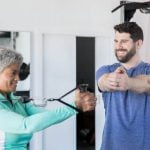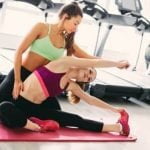Functional fitness workouts for home gyms are ideal for people who are looking to get fit without a gym subscription. These types of workouts involve focusing on movements and exercises that improve your body’s functional strength. They focus on core, balance and coordination as well instead of isolation exercises typically performed in the gym. Functional fitness home workouts have numerous benefits including increased mobility, improved coordination and balance, increased muscular endurance, and an overall better quality of life.
Benefits of Functional Fitness Workouts There are a variety of functional fitness workouts that can be done at home with minimal equipment or with nothing at all. One great benefit is that they do not require a lot of space or equipment.
Therefore the cost is low compared to traditional gym-based activities such as weight lifting or running machines. They also put less stress on your body due to not having to lift heavy weights and they allow you to move freely in open spaces which helps with creating muscle memory as well as improving coordination skills.
Exercises Used In Functional Fitness Workouts The key focus during these workouts are compound movements such as squats, deadlifts, pulls ups, planks, push ups etc. Compound movements use multiple joints together which leads to multiple muscles being used simultaneously which makes it mentally stimulating because you must pay attention constantly throughout the workout if you want to do it correctly without straining yourself too much.
Adding in explosive movements incorporated into workout circuits will help increase muscular strength by increasing power production capacity through heavier lifts and jumps – this can also provide mental stimulation due to having to perform complex motor co-ordination moves quickly under pressure whilst keeping an eye out for good form.
Other exercises often used in functional fitness programs include kettlebell swings, burpees, box jumps, farmers walks amongst many others which helps increase metabolic conditioning since you will be aiming for higher repetitions and fatigue resistance.
Defining and Explaining Functional Training
Functional fitness training can be defined as an intense workout that uses movements and exercises similar to those found in a sport or activity of daily living. Unlike other types of gym workouts, functional training typically involves exercises that use multiple muscle groups at the same time.
This type of exercise simulates typical motions that take place in sports and everyday activities such as lifting boxes, carrying groceries, and climbing stairs. As a result, functional training enables individuals to develop strength, stability, flexibility, balance, endurance and coordination in both their spine and joints which contributes to improved overall physical health.
Benefits of Functional Fitness Training
The benefits associated with functional fitness training are immense. People find this type of exercise appealing because it not only helps them develop improved strength but also allows them to move more freely and fluidly when performing everyday activities like picking up children or playing sports like tennis or golf.
Furthermore, performing functional movements increases both the range of motion throughout the entire body as well as improve core stability which is necessary for injury prevention during physical activities. Additionally, tougher variations of these exercises can also increase cardiovascular capacity leading to improved stamina levels.
Types Of Functional Exercises For Home Gym
Functional fitness workouts can be done from home using either dumbbells or kettlebells in combination with bodyweight exercises such as squats, lunges and bent over rows. Squats strengthen the legs while lunges stretch out the glutes and hips; similarly bent over rows target the muscles around our backs and shoulders providing increased core support.
All these exercises involve multiple muscle groups simultaneously making each repetition more efficient on total body muscles activation rather than doing isolation or static exercises such those found on machines at a gym where there is limited movement allowing for emphasis on individual sections of the body e.g biceps curls or tricep extensions done on weight benches.
Doing resistance band workouts is also beneficial when trying to construct a full body home circuit using minimal equipment as they allow freedom of movement while still engaging multiple muscle groups at once due to their varying levels resistance tension when shifted from side to side.
Benefits of Functional Fitness Workouts
Functional fitness workouts are becoming increasingly popular for people at home. This type of workout focuses on using movements and activities that replicate day-to-day activities, such as picking up groceries or vacuuming, rather than bodybuilding moves. Functional fitness workouts can help people reach their goals faster than traditional weight lifting, and with fewer visits to the gym since they can be done from home.
The best part about functional fitness workouts is that they offer a wide range of benefits to anyone who participates in them. One of the biggest benefits is improving strength throughout the body. Unlike traditional weightlifting which focusses on isolating individual muscles to lift heavier weights, functional movements target several muscle groups at once, resulting in greater whole body strength.
Additionally, functional workouts also improve balance and posture because they require participants to use continuous motion while keeping their core muscles activated. This has long term effects on posture and helps reduce lower back pain caused by poor form or weak core muscles from sitting too much.
Functional exercises also incorporate cardio into each workout, making it an efficient way to get fit as cardiovascular training is built-in because movements are continuous and varied rather than repetitive like running on a treadmill. Functional exercises focus on joint movement rather than muscle size, so these grueling exercises improve mobility and flexibility more so than other more concentrated lifting routines would.
Overall, functional fitness are great for those trying to exercise from the comfort of their own home since there’s no need for heavy weights or expensive equipment; however individuals should still consult with a professional before starting any new routine in order to prevent injury or burn out.
Essential Equipment Needed For Home Gym Functional Workouts
The beauty of creating a home gym means you can tailor it to your specific needs. However, regardless of how specific or individualized your home workout is, certain pieces of equipment are essential for full body functional workouts. Depending on the results you aim to achieve, certain modifications should be bought over others. Listed below are some key pieces of equipment that are found in any well-equipped home gym:
- Adjustable Weighted Dumbbells
- Kettlebells
- Exercise Bands with Handles
- Suspension Trainers
- Yoga Mats & Foam Rollers
- Speed Ropes
Adjustable Weighted Dumbbells
Adjustable Weighed Dumbbells offer an incredibly versatile and ever-changing way to build muscle strength while also helping burn fat. They come in two forms which are multi-gyms weights and adjustable selectable dumbbells.
Multi-gyms weights have pre-fixed ranges of weight – therefore offering series’ based exercises without the need to change them up often. Selectable push button dumbbells allow for quickly increasing or decreasing the weight used during each exercise – meaning a longer range of exercises that cover multiple muscle groups, like presses, squats, and curls.
Kettlebells
Kettlebells have become hugely popular as they provide exercises every day people can do relatively easily from home or even outside. As well as this, they help master everyday movements; most kettlebell exercises mimic our daily motions like picking things up off the floor or swinging objects overhead. Mastering these regular movements with added weight helps produce more muscular strength and better endurance when performing our everyday tasks.
Exercise Bands with Handles
Resistance bands offer a great alternative to free weights due to their low impact intensity level, but still providing an intense level of resistance – allowing muscles from all parts of your body to work at maximum capacity. With handles either side it allows for greater control and stability when exercising which is ideal when beginning fitness plans.
Examples of Functional Fitness Exercises
Functional fitness workouts focus on training movements instead of muscles. This type of workout is often used by athletes as it helps to improve performance and reduce injury. With the correct equipment, these exercises can be done in the comfort of your home gym.
Examples of functional fitness exercises include bodyweight exercises such as squats, lunges, press ups, planks, step ups and pull ups. These exercises use multiple muscle groups at the same time to increase flexibility, balance and coordination while developing strength and endurance.
Using a mini-trampoline will add variety and intensity to your workout. Rebounding helps activate deep muscles in your core while strengthening coordination skills due to the instability of the trampoline beding surface.
Adding a medicine ball into your routine will help increase power and build stabilization strength when performing Olympic lifts like the Clean & Jerk or Snatch. The multi-directional and explosive nature of medicine drills makes them ideal for improving an athlete’s speed and agility as well as their overall performance.
Kettlebells are another fantastic addition to any home gym set up for functional fitness workouts. Kettlebells help train the whole body quickly using compound movements that require more than one joint movement at once which increases metabolic output resulting in increased calorie burn rate.
They have become popular due to their flexibility in being able to do both upper-body exercises like tricep extensions or shoulder presses as well as lower body exercises such as swings and kettlebell lunges; all which can be done with greater resistance compared to traditional movements using dumbbells or barbells due to their off-centre load distribution.
Strategies For Planning Home Gym Workouts
Having a home gym can be an incredibly convenient way to exercise. Designing workout plans and programs require functional fitness strategies that do not require much equipment, or any at all when setting up a home gym. This enables anyone to have access to their very own personal training program that they can tailor according to their body needs and goals.
In order to make sure your home gym workouts are effective, it’s important to create a well-developed, progressive plan with different exercises and intensity levels. The right strategies for planning will depend on the individual, but some of the most common types of exercises used in home gyms are bodyweight movements such as squats, lunges, push-ups and pull-ups.
These movements recruit multiple muscles simultaneously and can provide a great full-body workout. All of these exercises do not involve any type of weights or machinery so there is no need for buying extra equipment when creating workouts for your own home gym space.
Another key component for effective home gym workouts is including strength training exercises into your routine in addition to doing bodyweight movements. Establishing proper form with kettlebells, barbells and resistance bands will help you build lean muscle mass and become stronger overall.
Combining different forms of resistance workouts within the same session can help increase variety by engaging different muscles groups in various ways every time you work out. Additionally, integrating this into your daily routine allows you to maintain an active lifestyle while achieving results within the comfort of your own home.
To ensure efficient use of time for your home gym workouts, it’s essential to track your progress through recording sets and reps regularly. Doing this allows you to monitor any potential improvements over time and adjust the intensity levels as needed for further progress. By following through with all these strategies for planning, individuals can benefit from having access to personalized workout plans in the comfort of their own homes without needing additional tools or resources.
Modifying Home Gym Workouts to Suit Your Performance and Goals
Functional fitness workouts are an important part of any home gym. These exercises train the body to become more efficient and better equipped to perform everyday tasks. The term ‘functional’ essentially refers to training that has an element of usefulness or practicality, such as increasing strength and endurance for daily activities. It’s important to tailor your recreational approach and use functional moves that suit your personal performance and goals.
Focus On Progressive Overload
What’s key with functional fitness is the concept of progressive overload – continually challenging the body through new movements or increasing the resistance levels to keep improving physical performance over time. This is why it is important to be aware of muscles you may be over-straining, to factor in rest days (as fit in your routine as exercise days) and monitor progress closely with written notes or using digital tracking devices.
Progressively making changes by building on existing routines can help exceed expectations when working out at home; adding weight, doing more reps, longer cycles or incorporating cardio elements into lifting sessions are all good targets. Be sure to listen to you body during these workouts for cues regarding what can be handled safely during each session too.
Reconciling Flexibility And Resistance
Your chosen home gym routine should also focus on balancing flexibility with resistance training which allows proper range-of-motion through the various exercises while engaging multiple muscle groups at once for maximum benefit from each session.
You can train larger muscles such as chest, back, hips and legs with compound lifts that involve multiple joints such as a squat or deadlift while also targeting smaller muscle groups like rotator cuffs and calves by doing isolation exercises using machines or free weights.
Additionally, including stretches within every workout will improve mobility skills without compromising heavier lifts; adding planks between sets will help safety warm up those core muscles before attempting riskier moves like overhead squats as well as aiding stability when lifting heavier weights at a later date too.
Making Use Of Unorthodox Training
Finally, don’t forget about unorthodox maneuvers – they’re just as essential in providing beneficial functional fitness workouts in a home gym setting too. Utilizing everyday objects such us chairs for dips or resisance bands can create a different set of challenges perfect for keeping both mind and body engaged during each session.
Tackling classic game drills with sports equipment like ladder agility runs incorporate unique patterns where plyometrics may not (or cannot) be utilized indoors on a wide enough scale either due to limited space/distance restrictions endemic of most domestic gym settings so do break out the ladder now and then if needs must.
Advice for Maintaining a Functional Fitness Workout Routine at Home
Maintaining a functional fitness routine at home can be beneficial to help improve one’s overall physical aptitude. Functional fitness workouts are designed to be exercise movements that resemble those seen in everyday activities, promoting functionality and improved agility. This type of fitness routine can be done with minimal equipment, and is great for both beginners and experienced athletes alike. Below are some tips for ensuring you get the most out of your functional fitness workouts at home.
First, it is important to know what you need for these workouts. A basic set-up would include free weights, such as dumbbells or kettlebells, resistance bands, a step platform if available, an exercise mat or large towel, and a timer or clock.
Depending on the type of workout you are doing, other items such as medicine balls or stability balls may also be needed. Knowing what you need ahead of time will ensure that you have everything on hand before beginning your workout routine.
Second, it is beneficial to have an understanding of proper form and execution when practicing any new exercise movement associated with functional fitness routines. Ensuring correct posture helps protect your body from injury while helping further increase your overall strength and agility gains.
Any real-time guidance may best be sought by consulting with a certified personal trainer; however, online tutorials can also work in teaching more complex techniques for completing squats and lunges correctly or safely executing certain presses with free weight systems.
Additionally, there are several instructional DVDs available for purchase to help guide beginners towards working out safely and effectively from home; these guides could include step-by-step instructions accompanied by visual demonstrations as well as nutritional guidance specific to functional fitness goals.
Finally, it is essential to remain consistent with any home fitness program; consistency often creates tangible results more quickly than sporadic participation may lead to achieving desired goals over time. Staying motivated during long periods of structured activity can lead one closer to reaching their desired plateau when exercising regularly-build healthy habits by committing yourself into having a strict schedule.
Establishing set days throughout the week dedicated devote solely towards physical endeavors not only allows you to progress quicker but helps laydown good foundations for years to come.

Passionate about providing useful information to anyone with an interest in the field of Personal Training, I strive to pass on to our readers quality information and to answer any questions about Personal Trainers, the work they do and how to become one.





